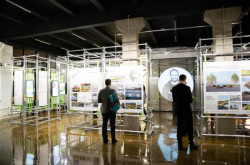St. Petersburg’s unique image
Many places have embraced the “smart city” concept in recent years. All in all, there are two types of smart cities: new cities built smart from the start, such as Songdo City in South Korea, or Masdar City in the UAE, and existing cities made smart, such as New York City, Copenhagen, Vienna, etc. St. Petersburg also falls into this second group.
However, every city is unique and “smart” in its own way: some cities are characterized by a wide variety of digital and electronic technologies, while in other cities, people pay a lot of attention to environmental protection and social security.
“What makes our approach to smart cities really special is that we give priority to our citizens. Our approach is human-centric: we want to design a city for people, a city that would be more comfortable to live in. And we want people to get involved in this process and come up with their ideas on how to change our city for the better,” shared Sergey Drozhzhin.
That is, making a city smart doesn't just mean investing heavily in IT, but, first of all, providing solutions to those issues that matter the most to people. IT is just one of the many tools required to improve the quality of life.

How will it work?
The project’s developers have already launched a website where people can learn more about the project and share their ideas and suggestions on how to improve the situation in the city. To do so, they only need to fill in an application form.
Who can apply?
- All residents of St. Petersburg.
- Developers of various urban development projects concerning energy-efficient lighting, green spaces, social infrastructure, public information amenities, etc.
These two groups of applications are processed differently.
Applications submitted by project developers
Companies and startups in the field of urban development can use the platform to upload their projects. Their suggestions will undergo several stages of assessment:
- Every application is first reviewed by a moderator.
- The project is then assessed by a group of experts.
- Concurrently, the project is shared on the website where every citizen can have their say.
- If the project is approved by both experts and citizens, it is included on a list that will be submitted to the Governor of St. Petersburg.

“Such a multi-stage process allows us to evaluate the projects in terms of their relevance, efficiency, and benefit for the citizens. It is also important to note that the pool of experts will be constantly growing in order to minimize the risk of fraud, when certain projects are evaluated by people who can benefit from their realization. Of course, there’s still a risk of fraud when it comes to counting public votes, but this has more to do with information security. That’s why we need experts, so that they thoroughly evaluate every project before making a decision,” explained Sergey Drozhzhin.

Another advantage of this project is that it’s not only citizens and experts who can get access to the projects, but potential investors as well.
Applications submitted by citizens
Citizens don’t have to think whether their ideas are relevant or not. They can make suggestions on any issues that might need to be addressed, such as improving sidewalks and roads, reducing the number of cars in the city center, introducing electronic queues in hospitals, etc. But what is notable about the project is that it is focused more on new ideas and suggestions rather than complaints.
The developers have also conducted a survey among the citizens of St. Petersburg on what aspects of urban infrastructure need urgent attention the most. 384 people took part in the survey. According to the results of the survey, the most problematic sectors are: public transit, roads, parking lots, traffic jams, litter, and beautification of the city.

“With the help of information technologies and a clear evaluation system we can make the decision-making process more transparent. Thus, citizens will trust city officials more, while the officials, in turn, will start taking the citizens’ opinion into account. The purpose of this project is to make the communication between citizens and officials more effective,” said Mr. Drozhzhin.
What is done and what has to be done
The "Smart St. Petersburg" team is currently in the process of developing the project's technical and legal aspects, and considering the possibility of launching the government program “Smart St. Petersburg”. They are also working on the mechanism of assessment and expertise, and collaboration with the federal authorities.
As part of this project, scientists and researchers from ITMO University are also working on IMPRECITY, a project that would allow users to visualize information about citizens’ feelings about the city and its various public spaces, and then form groups that would work on certain projects.




